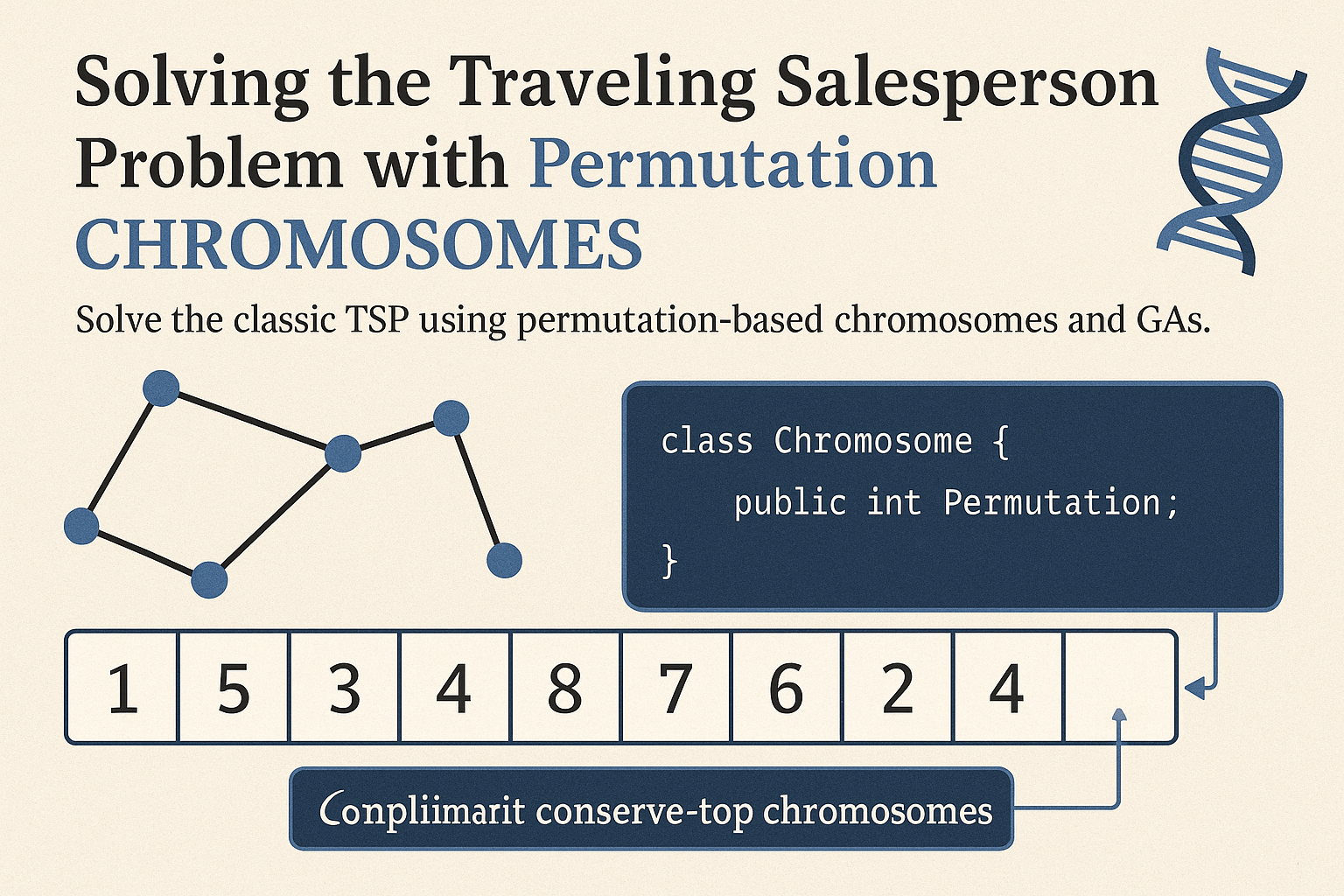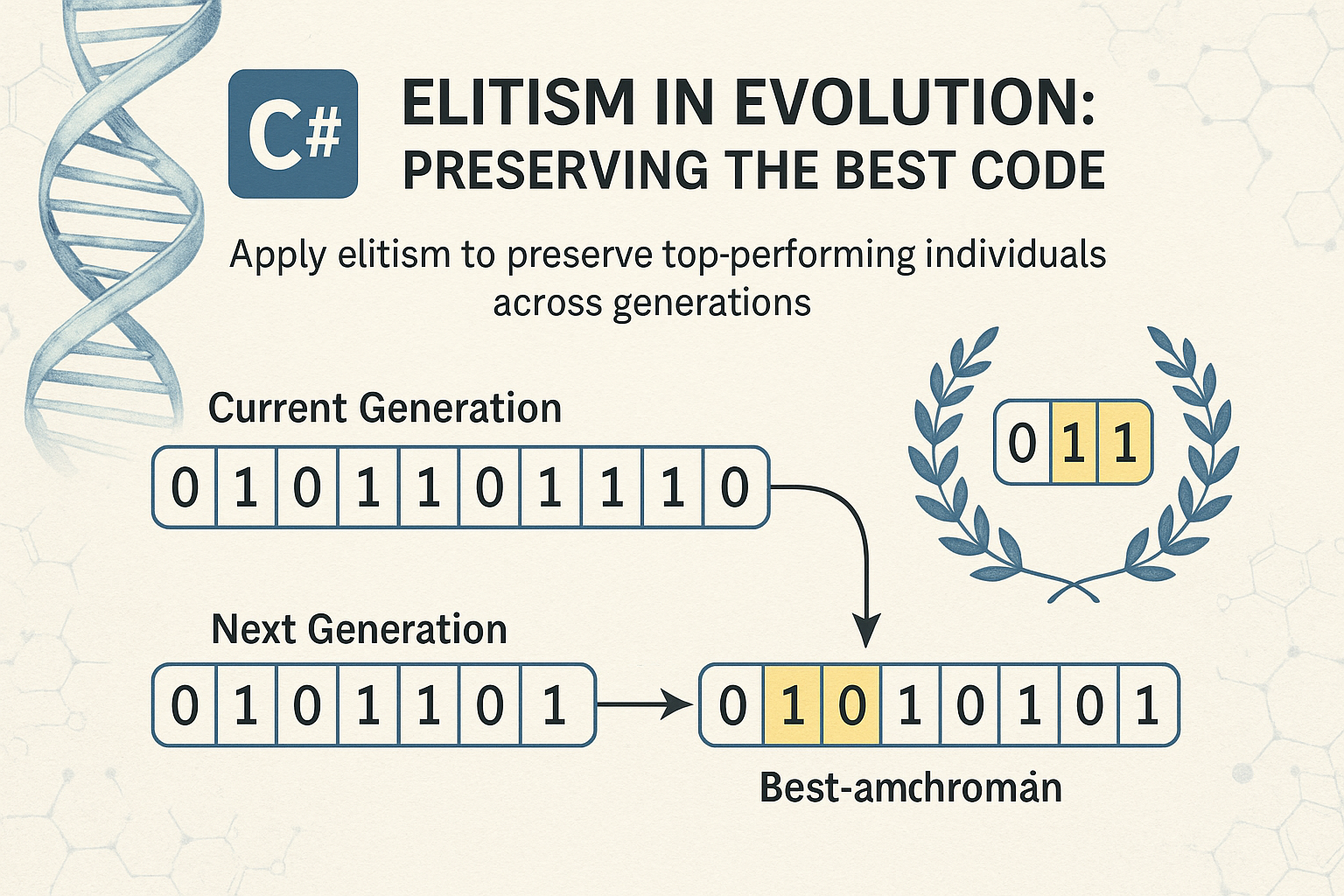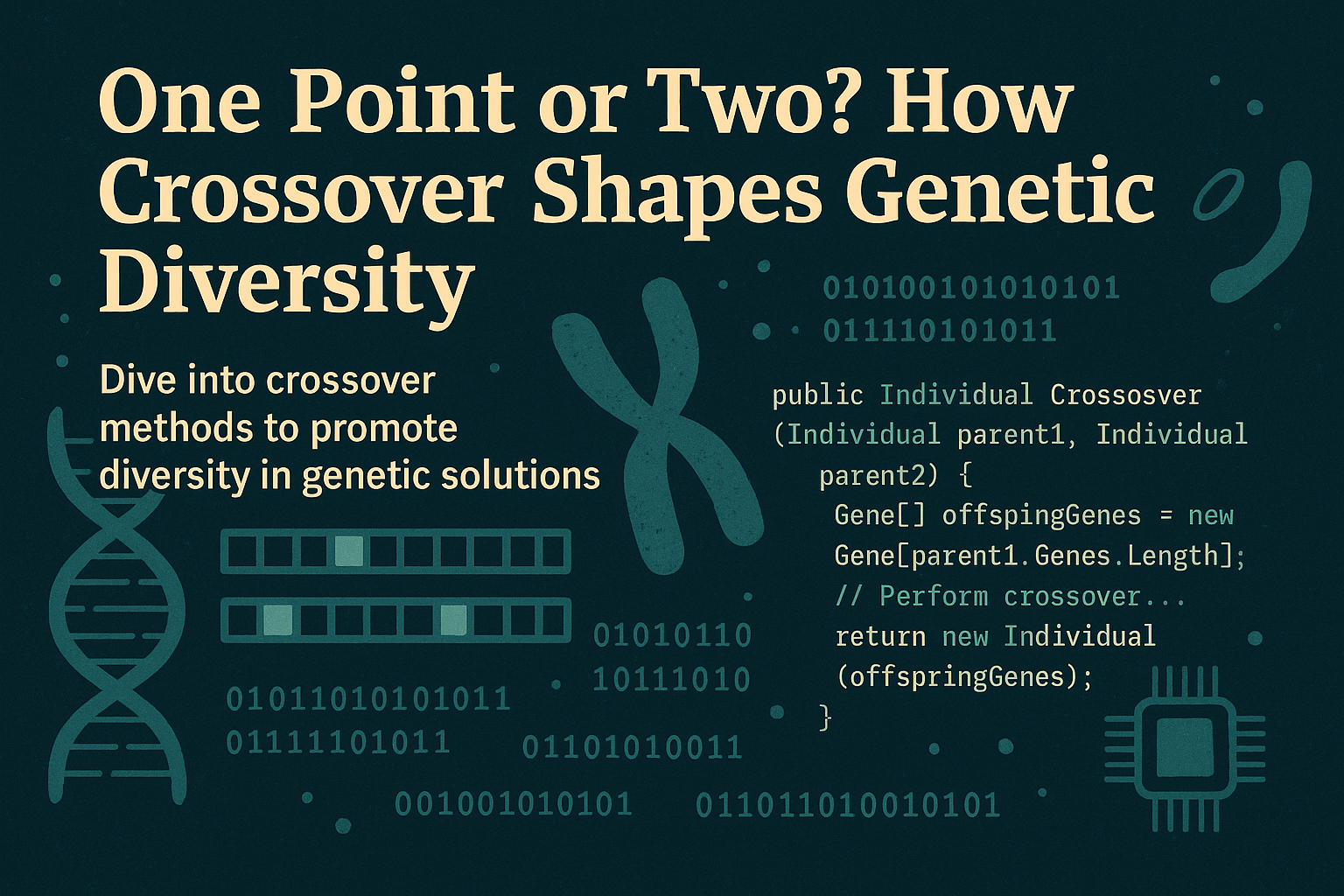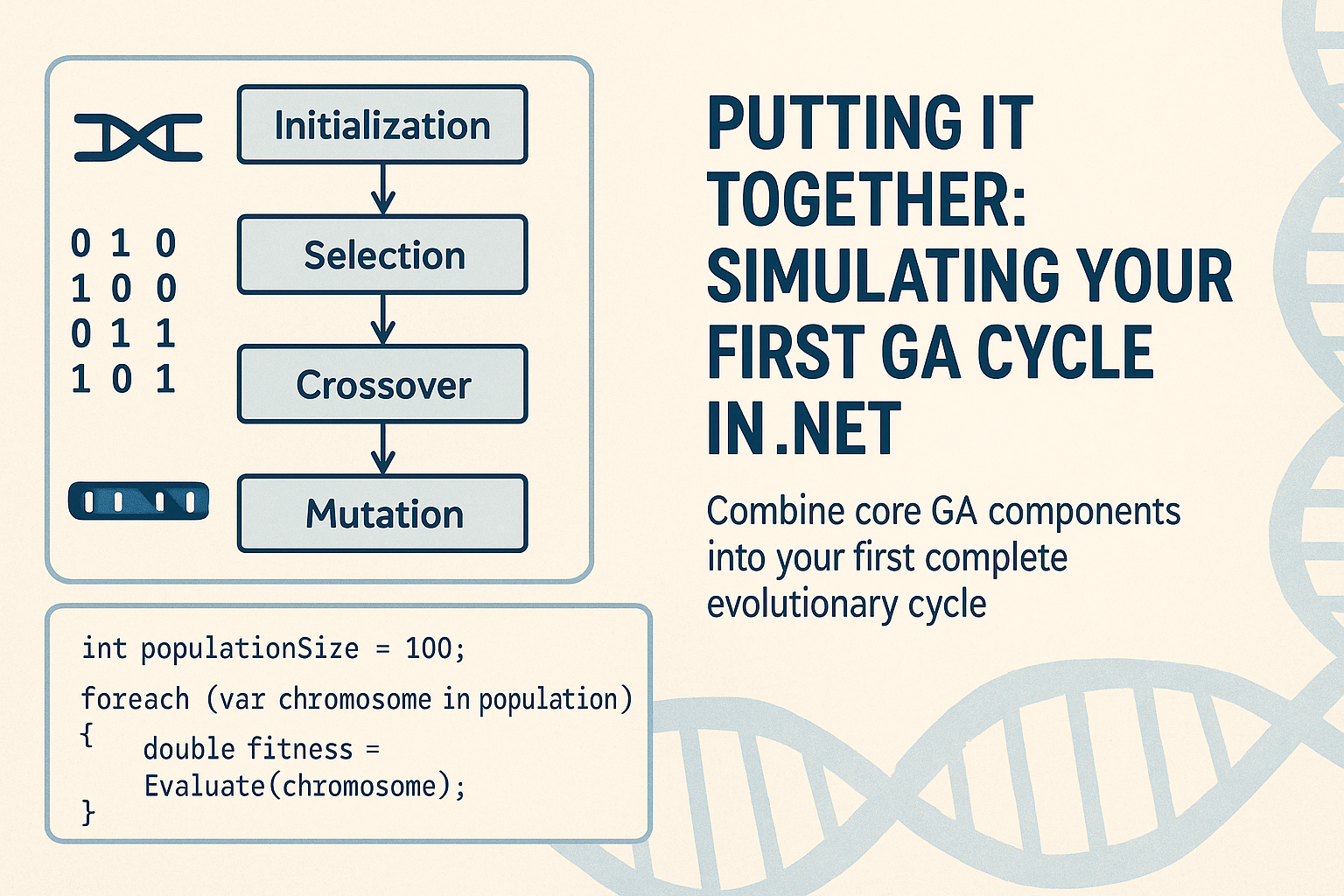Day 16: Solving the Traveling Salesperson Problem with Genetic Algorithms Permutation Chromosomes
The Traveling Salesperson Problem, also known as TSP, is one of the most extensively studied combinatorial optimization problems in computer science. Given a set of cities and the distances between them, the objective is to find the shortest possible route that visits each city exactly once and returns to the starting point. This problem is computationally difficult to solve using brute-force methods because the number of possible routes grows factorially with the number of cities.
Continue Reading
Day 15: Fitness by Design: How to Shape the Problem to Match Evolution
In genetic algorithms, the fitness function is not just a scoring system—it is the definition of success. Your entire evolutionary process hinges on how well the fitness function communicates what “better” means in the context of your problem. If the fitness function rewards the right behaviors, your algorithm will evolve meaningful solutions. If not, you may end up optimizing toward the wrong objective or stuck in a plateau of mediocrity.
This post focuses on how to design fitness functions that align with your goals, reflect nuanced problem definitions, and promote useful evolution. Whether you are evolving strings, optimizing numbers, or solving real-world configurations, the fitness function is where the problem and solution space meet.
Continue Reading
Day 14: Evolving Text: Solving the “Hello World” Puzzle with a C# Genetic Algorithm
Now that you’ve built the complete set of genetic algorithm components, chromosomes, fitness functions, mutation, crossover, selection, and a configurable loop, it’s time to apply everything in a hands-on project. In today’s post, we’ll use a genetic algorithm to evolve a string toward a target phrase: “HELLO WORLD”.
This classic exercise helps demonstrate how genetic algorithms work in a tangible, visual way. You’ll see the population of strings gradually improve, letter by letter, until they match the target. It’s a powerful example of emergent behavior through selection and variation.
Continue Reading
Day 13: Configuring the Genetic Algorithm Loop in C#
A genetic algorithm is only as effective as the loop that drives it. While selection, crossover, mutation, and elitism form the backbone of a genetic algorithm (GA), it is the configuration of the evolution loop that determines how the algorithm behaves over time.
Today’s focus is on designing and implementing the loop that runs your genetic algorithm. We will examine how to parameterize the loop with values such as population size, mutation rate, elite count, and maximum generations, and how to structure your logic to support reusable, testable, and adaptable evolutionary flows in C#.
Continue Reading
Day 12: Genetic Algorithms’ Elitism for Evolution Survival of the Fittest
Natural selection favors the survival of the fittest, but evolution in the wild is not always efficient. In genetic algorithms, we can bias the process toward faster convergence by deliberately preserving top-performing individuals across generations. This technique is known as elitism, and it is one of the simplest yet most effective strategies for enhancing GA performance.
Today’s post focuses on applying elitism in a C# genetic algorithm to ensure that the best solutions are never lost. We will define elitism, explain its impact on the evolutionary process, and demonstrate how to implement it cleanly and effectively.
Continue Reading
Day 11: Implementing a C# Mutation Operator for Genetic Algorithms
In yesterday’s post, we explored the importance of mutation in genetic algorithms. Mutation helps maintain genetic diversity, prevent premature convergence, and enable the discovery of better solutions through small, random changes. Today, we shift from theory to implementation.
Our goal is to code a mutation operator in C# that is both configurable and adaptable to different types of chromosomes. This operator will be a core component of your genetic algorithm loop, introducing the right level of randomness into your evolutionary process.
Continue Reading
Day 10: Mutation Matters in C# Genetic Algorithms
In biological evolution, mutations are rare, random changes in DNA that introduce new traits. While many mutations are neutral or even harmful, some spark evolutionary leaps. In genetic algorithms, mutation serves the same purpose: injecting fresh variations into the population to avoid stagnation and premature convergence.
Without mutation, a genetic algorithm can easily fall into local optima—improving early on but plateauing before reaching the best solution. Mutation helps keep the algorithm dynamic, ensuring exploration continues even when the population becomes homogeneous.
Today, we explore how mutation works, its importance in the evolutionary process, and how to implement it in C#.
Continue Reading
Day 9: Using Genetic Algorithm’s Uniform Crossover in C#
So far, we’ve explored one-point and two-point crossover strategies, which split chromosomes at predefined positions. These methods are effective for maintaining gene sequence structure, but they can be limiting when diversity is crucial. Enter uniform crossover—a technique that treats each gene position independently, offering greater mixing and a finer-grained approach to recombination.
Today, we’ll implement uniform crossover in C#, compare it with other strategies, and explore when and why you should use it.
Continue Reading
Day 8: One Point or Two? How Crossover Shapes Genetic Diversity
In the evolutionary process, crossover is the mechanism by which parents pass on their traits to offspring. In genetic algorithms, crossover plays the same role, combining genes from two parent chromosomes to produce new solutions. How you implement crossover significantly impacts the algorithm’s ability to explore the search space and avoid premature convergence.
Today, we dive into crossover methods in C#, comparing one-point, two-point, and uniform crossover, and how each influences genetic diversity.
Continue Reading
Day 7: Putting It Together: Simulating Your First Genetic Algorthm Cycle in .NET
By now, you’ve learned the foundational components of genetic algorithms: chromosomes, genes, fitness functions, mutation, crossover, and selection. Today, it’s time to bring those elements together and run your first complete GA cycle using C# and .NET.
This post walks you through the structure of a single evolutionary loop—initialization, evaluation, selection, reproduction, and mutation—so you can simulate a working genetic algorithm and evolve real solutions.
Continue Reading












